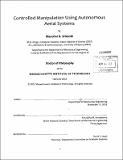| dc.contributor.advisor | Anuradha M. Annaswamy. | en_US |
| dc.contributor.author | Srikanth, Manohar B. (Manohar Balagatte) | en_US |
| dc.contributor.other | Massachusetts Institute of Technology. Department of Mechanical Engineering. | en_US |
| dc.date.accessioned | 2013-06-17T19:53:17Z | |
| dc.date.available | 2013-06-17T19:53:17Z | |
| dc.date.copyright | 2012 | en_US |
| dc.date.issued | 2013 | en_US |
| dc.identifier.uri | http://hdl.handle.net/1721.1/79286 | |
| dc.description | Thesis (Ph. D.)--Massachusetts Institute of Technology, Dept. of Mechanical Engineering, February 2013. | en_US |
| dc.description | Cataloged from PDF version of thesis. | en_US |
| dc.description | Includes bibliographical references (p. 134-135). | en_US |
| dc.description.abstract | The main focus of the thesis is to design and control Autonomous Aerial Systems, also referred to as Unmanned Aerial Vehicles (UAVs). UAVs are able to hover and navigate in space using the thrust forces generated by the propellers. One of the simplest such vehicles that is widely used is a Quadrotor. While UAVs have been predominantly used for "fly and sense" applications, very few investigations have focused on using them to perform manipulation by contact. The latter is challenging because of the dual goal of performing manipulation and maintaining stable flight. Because Quadrotors can quickly reach a location, their ability to manipulate can be impactful in many scenarios. While efficient flight control of Quadrotor has been an active research area, using Quadrotor to perform manipulation is novel and challenging. In this thesis, a range of Quadrotor designs and control strategies are proposed in order to carry out autonomous manipulation of objects. We first derive a dynamic model of the Quadrotor that accounts for the presence of contact, object dynamics and kinematics. To improve manipulation performance, a passive light-weight end-effector interface between the Quadrotor and the object is proposed. The complexity of the dynamics is systematically reduced by making certain assumptions. The resulting dynamic model is divided into nonlinear subsystems on the basis of their degrees of freedom, for each of which separate controllers are designed. An efficient docking approach is proposed that permits fast and aggressive docking, even at very high speeds. Because a single Quadrotor UAS is limited in manipulation capability, a multi Quadrotor cooperative manipulation scheme is proposed. Control strategies are proposed to deal with kinematic and parametric uncertainties. A manipulation scheme to open a door with unknown hinge location is proposed. A nonlinear adaptive controller is implemented to perform efficient tracking in the presence of parametric uncertainty. In order to improve robustness to accidental contacts, a novel flexible Quadrotor, denoted as ParaFlex, is designed. The advantages of ParaFlex over a rigid Quadrotor are demonstrated. A Simulation, Test and Validation Environment (STeVE) is developed to facilitate smooth and efficient transition from design process to simulation to experiments. | en_US |
| dc.description.statementofresponsibility | by Manohar B. Srikanth. | en_US |
| dc.format.extent | 135 p. | en_US |
| dc.language.iso | eng | en_US |
| dc.publisher | Massachusetts Institute of Technology | en_US |
| dc.rights | M.I.T. theses are protected by
copyright. They may be viewed from this source for any purpose, but
reproduction or distribution in any format is prohibited without written
permission. See provided URL for inquiries about permission. | en_US |
| dc.rights.uri | http://dspace.mit.edu/handle/1721.1/7582 | en_US |
| dc.subject | Mechanical Engineering. | en_US |
| dc.title | Controlled manipulation using autonomous aerial systems | en_US |
| dc.type | Thesis | en_US |
| dc.description.degree | Ph.D. | en_US |
| dc.contributor.department | Massachusetts Institute of Technology. Department of Mechanical Engineering | |
| dc.identifier.oclc | 846906293 | en_US |
